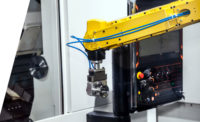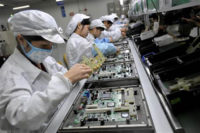Collaborative robots are an exciting area of growth for automation and manufacturing. A potentially useful and cost-effective automated tool for manufacturing, “cobots” can work safely with people in a shared workspace, enhancing flexibility and reducing risk. Compared to traditional robots, cobots offer the advantages of safety, relative ease of use, and lower cost. However, as useful as this technology promises to be, assemblers are still trying to understand it in many ways.
Because some suppliers introduced collaborative robots to the market via general distribution, it was natural for the technology to be seen initially as a commodity. Cobots were often sold by people with limited experience in robotic integration. The robots were marketed as inexpensive and easy to use—basically something that anyone could buy and set up. This inevitably led to problems, incorrect applications and lack of support. Often, end-users were left to make the most of a confusing situation.
Mistakes cost money—that’s why the support of an experienced integrator and early strategic planning for the use of cobots can make all the difference. In fact, in our experience, manufacturers could be wasting nearly $90,000 per year on each operation that requires the use of collaborative robotics, due to improper, insufficient or even nonexistent integration of the robots into their processes. Based on typical costs for a robot and hours in an industrial shift, this estimate is an example of the opportunities lost through not understanding this new industrial tool.
Using cobots in your process creates significant opportunities for manufacturing efficiencies, innovation and growth—as long as the integration of the robot is well designed and well implemented. However, the surge in development of these robots has led to a flurry of companies buying them without a well-defined set of objectives or good plan to use the cobot in their manufacturing processes.
According to our estimates, an inadequate implementation can cost a manufacturer $86,000 per operation per year, based on the cost of a cobot and the cost of unutilized time or down time by employees. (This estimate is based on a $100,000 robot and its peripherals, with utilization across a three-shift operation of 2,000 hours per shift per year, resulting in an approximate cost of $16 per hour.)
“We see this every day,” says Steve LaMarre, director of automation sales at Ultra Tech. “Our customers conscientiously invest in these robots—meaning possibly anything from $40,000 to $100,000—and then essentially let them sit on the floor without the right help in deciding how to properly utilize them. Money is just flying out the door.”
An integration specialist has the resources to serve, support and engineer robotic technology, and it has the experience to know how best to deploy the robot where it can be used well. This includes helping to integrate the human workers’ functions with those of the robot in an effective process. The integration specialists at Ultra Tech Automation always start a job with some key questions. These include:
- What does you want to accomplish with the cobot?
- What are the safety considerations and functionality?
- What is the thought process behind choosing a cobot?
“Once we understand why they are considering collaborative robotics, it opens up the discussion,” says LaMarre. “We’re seeking the best process, and this is one of the solutions. Sometimes focusing on their goals might even take them in a different direction.”
Many times the best solution may be a true collaborative application. In other cases, the job requirements could be accomplished through the use of a different automation tool with a well-engineered process, avoiding the compromises sometimes associated with cobots.
It’s never a simple challenge. In many cases, the decision to use a cobot turns on a company’s assessments of floor space and line speed. Nine times out of 10, the discussion comes down to access. For example, people must be able to access the machine to restock parts to be processed.
Here are some missteps common among companies initially trying to implement collaborative robots:
Lack of training or internal discussion of how the robot is to be used. Does everyone who will collaborate with the robot understand the roles of both human and machine? Do they know what outcomes are required? What metrics will guide usage?
Oversimplification. Don’t look at cobots as “plug-and-play” machines. These are advanced automation machines with specific functions. It’s still a robot. You’ll do better if you take the time to understand it and carefully structure it into your process.
Lack of planning, leading to misapplication. Ask yourself whether you are planning for one application or for a larger process. An application tends to be less complex and less dependent on upstream or downstream points in your process. A process requires you to see it in its entirety so you can strategize.
Growth and Innovation at Risk
Manufacturers that do not use cobots properly risk losing valuable growth opportunities—efficiencies, improvements to the line, enhancements to manufacturing quality and other advantages. They may also lose unique opportunities for innovation, which tends to occur on the shop floor in response to actual needs and challenges.
Ineffective utilization also can limit a manufacturer’s ability to make collaborative robotics work in pursuit of the company’s goals. Unfortunately, companies sometimes approach investment in a cobot in reverse order—buying the technology first, and then finding an application for it. This can put pressure on managers overseeing use of the robot to figure out how to develop process efficiencies or enhancements. Without some strategy or experience behind them, this can be a tough call. Even manufacturers with in-house engineering capabilities ultimately may not be using cobots as well as they could be. Because purchase of a cobot is sometimes directed by superficial knowledge of the technology, due consideration must be given to what functions will benefit—and how that function aligns with other parts of a manufacturer’s key process. If there’s no careful thought process involved, no one is going to be happy with the results.
Useful applications for cobots include palletizing, small-parts assembly, machine tending, packaging, polishing, machine tending and parts inspection. For instance, using cobots for automated inspection has potential for growth in manufacturing. To see why, it helps to understand the typical limitations of collaborative robots in applications: reduced reach, lower carrying capacity, and lower speed. They are typically more useful in processes that are less complex. Cobots operate in a smaller work envelope—that is, the robot’s range of movement (forward, backward, up or down) as determined by its arm length and axes. Because automated inspection doesn’t call for speed, long reach or heavy payload capabilities, it’s a very good application for cobots.
In comparison, if you hope to use a cobot in an atypical situation—such as picking up large parts—you may need to work with an integrator. Simply putting tooling on the end of the arm does not create a corner movement that will allow the arm to grip a large part. You need to understand the differences between how cobots and conventional robots work and plan accordingly. You will have better success in innovating your processes and achieving your goals if you do.
“It’s very likely that a lot of time and potential for innovation are lost because the attractiveness of using these robots is not always matched with enough help on the integration side of things,” says LaMarre. “We see manufacturers demanding the inclusion of cobots in processes, but to make this work well, they also need to understand the ins and outs of automation, or work with someone who does.”
Cobots Are Here to Stay
There is no doubt that collaborative robots are here to stay, and they offer real strategic advantages, such as enhanced line operations and opportunities for innovation. They provide competitive cost, integrated safety, lower risk, simplicity and flexibility. Their use can reduce repetitive-stress injuries or a need for new infrastructure. Long-term use of cobots can also introduce a manufacturer to broader ideas of what can be done with robots and automation.
“This is a very useful and accessible technology that also makes a great point of entry into the use of automation,” notes LaMarre. “Learn how to use cobots now so that you will be up to speed as they get more common, faster and better in years to come.”
The learning curve may start out steep, but can lower quickly as useful applications are derived. Taking the effort to understand the technology in the early days helps you. As a category of automation, they will only continue to grow, and once you understand the challenges, you can understand the opportunities.
“Learn everything you can at every stage, so you are ready to implement the next evolution as both software and hardware continue to improve,” says LaMarre.
Robots will continue to get smaller, faster, more efficient and more able to handle higher torque. There will be more applications for more environments.
Different aspects of a company’s work may be more suitable to collaborative robots than others. The complexity of industrial functions and process-driven employee activities means that every particular integration should be approached strategically. With hundreds of robotic applications, the very newness of cobots can be a challenge to success in deploying them.
It takes a deep understanding of manufacturing, scope of experience and strategic viewpoint to know what to do. Ultra Tech Automation has the skills and resources to be a source for making work shared by people and cobots productive and cost-effective in the industrial workspace.







